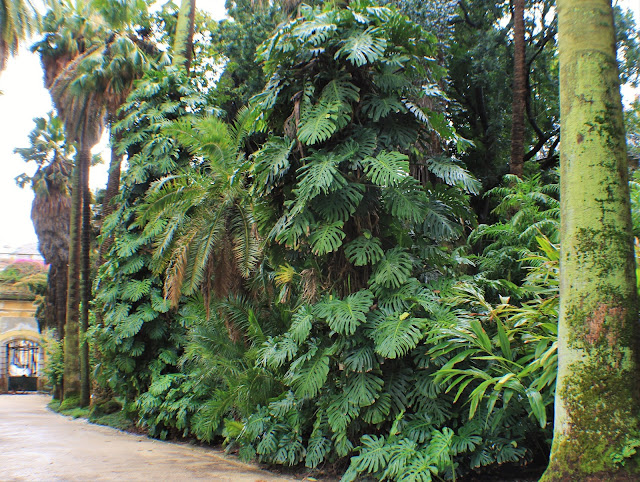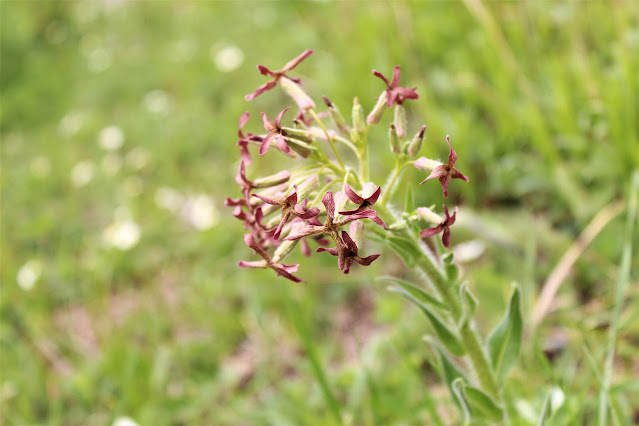O Jardim Botânico de Lisboa já abriu - The Botanical Garden of Lisbon as opened
1 ano e meio depois o Jardim Botânico de Lisboa finalmente reabriu. Uma obra com custo aproximado de 500 mil euros permitiu renovar diversos aspetos deste espaço: os percursos pedonais; o sistema elétrico e introdução de wi-fi em todo o jardim; novos bebedouros; um novo anfiteatro; e a recuperação do icónico lago. Estas são apenas algumas das novidades, e muitas outras conclusões de obras estão previstas para os próximos tempos.
O jardim faz parte do Museu Nacional de História Natural e localiza-se em pleno coração da cidade, na rua da Escola Politécnica, nº54 1250-096 Lisboa e é considerado desde 2010 como Monumento Nacional.
The Botanical Garden of Lisbon finally reopened a year and a half later. With an investment of approximately of 500 thousand euros allowed to renew several aspects: the pedestrian paths; the electrical system and the introduction of wi-fi throughout the garden; new drinking fountains; a new amphitheatre; and the recovery of the iconic lake. These are just a few of the novelties, and many other works are due to be concluded in the near future.
The garden is part of the National Museum of Natural History and it is located in the heart of the city, in the Rua da Escola Politécnica, nº54 1250-096 Lisbon and it is considered since 2010 as a National Monument.
A estrutura geográfica do jardim apresenta um acentuado declive, que, consequentemente, origina diferentes ecossistemas naquele espaço com cerca de 4 hectares. 1 dos hectares é chamado de 'Classe' onde está uma coleção de algumas famílias de dicotiledóneas e de gimnospermas. Este espaço foi projetado pelo alemão Edmund Goeze.
A restante área foi cuidadosamente pensada de forma a que pudesse englobar exemplares de toda a parte do globo terrestre. Plantas como as suculentas foram colocadas no topo do jardim, onde existe menos humidade e maior exposição solar. Lá em baixo foram colocadas espécies que preferem mais humidade e temperaturas um pouco mais reduzidas. Em determinadas alturas do ano a diferença térmica varia cerca de 2ºC entre estas duas zonas. Estes 3 hectares que aglomeram este arboreto foram idealizados pelo visionário Jules Daveau.
The geographic structure of the garden presents a steep slope, which, consequently, originates different ecosystems in that space with about 4 hectares. 1 of the hectares is called 'Classe' which holds a collection of some families of dicotyledons and gymnosperms. This space was designed by the German Edmund Goeze.
The remaining area was carefully thought out so that it could encompass all parts of the globe. Plants such as succulents were placed on top of the garden, where there is less humidity and greater sun exposure. On the lower part of the garden were placed species that prefer more humid and slightly reduced temperatures. At certain times of the year the thermal difference varies about 2ºC between these two zones. These 3 hectares that agglomerate this arboretum were idealized by the visionary Jules Daveau.
Estive em primeira mão a assistir a uma visita guiada ao novo espaço poucos dias depois da sua abertura. Estava muito interessado em conhecer melhor o espaço e as suas espécies, bem como trazer uma nova matéria bem fresquinha para o meu blog. Muitas coisas aprendi, mas só irei revelar algumas. O meu intuito é, claramente, aguçar a vossa curiosidade e interesse, e fazer-vos levar a conhecer este espaço.
I attended a guided tour of the the renewed garden a few days after its opening. I was very curious in discovering the new space and its species better, as well as eager to write about it. Many things I have learned, but I will reveal only a few. My intention is to whet your curiosity and interest, encouraging you to visit it.
A Dracaena draco (família Dracaenaceae), popularmente conhecida por Dragoeiro, é um dos exemplares mais exuberantes logo próximo da bilheteira. É originária da Macaronésia. As suas folhas quando caiem libertam uma seiva que fica avermelhada em contacto com o ar devido à sua oxidação. A Lenda de Hércules está associada a esta planta, uma vez que este herói no seu 11º trabalho teve de lutar com um dragão com 100 cabeças. Cada gota de sangue derramada pelo dragão ao cair no chão dava origem a um dragoeiro.
The Dracaena draco (Dracaenaceae family), popularly known as Drago, is one of the most exuberant specimens near the tickets' office. It is native to the Macaronesia. Its leaves, when they fall, release a sap that becomes reddish with the air due to its oxidation. The Legend of Hercules is associated with this plant, since this hero in his 11th job had to fight a dragon with 100 heads. Every drop of blood spilled by the dragon upon falling to the ground gave rise to a Drago.
 |
| Dracaena draco |
 |
| Seiva da Dracaena draco | Dracaena draco sap |
A coleção de palmeiras é uma das mais emblemáticas de sempre. O jardim botânico de Lisboa (pelas razões mencionadas anteriormente) consegue albergar mais de 20 espécies diferentes ao ar livre.
The collection of palm trees is one of the most emblematic of all time. The Botanical Garden of Lisbon (for the reasons mentioned above) manages to host more than 20 different species in the open air.
A Cinnamomum camphora (família Lauraceae) pertence à mesma família que a árvore de onde ser retira a canela. As suas folhas quando partidas ou secas libertam um aroma a cânfora.
The Cinnamomum camphora (Lauraceae family) belongs to the same family as the tree from which it is withdrawn the cinnamon. Its leaves when broken or dried release a scent of camphor.
 |
| Cinnamomum camphora |
A Erythrina caffra é uma linda árvore que fica preenchida por belas flores vermelhas, dando a ilusão que a árvore está em chamas. Pertence à família Fabaceae e como todas as espécies desta família uma das características são as flores com 10 estames. O fruto avermelhado assemelha-se a um feijão frade e é dispersado para longe através das aves que destes frutos se alimentam. O fruto perde a sua cápsula protetora dentro do estômago devido ao meio ácido e quando são defecados estão prontos para germinar.
The Erythrina caffra is a beautiful tree that is filled with beautiful red flowers, giving the illusion that the tree is on fire. It belongs to the Fabaceae family. As all species of this family, one of the characteristics are the flowers with 10 stamens. The reddish fruit resembles a monkey bean and is scattered far away through the birds that feed on these fruits. The fruit loses its protective capsule inside the stomach (of those birds) due to the acidic medium and when they are defecated they are ready to germinate.
 |
| Flor de Erythrina caffra | Erythrina caffra flower |
 |
| Fruto de Erythrina caffra | Erythrina caffra fruit |
A Monstera deliciosa (família Araceae) é uma planta tropical nativa do México e, contrariamente ao que muitos podem imaginar, é uma planta trepadeira, que se suporta noutras árvores para poder apanhar luz solar.
Monstera deliciosa (Araceae family) is a tropical plant native to Mexico and, contrary to what many may imagine, it is a climbing plant, which supports on other trees to catch sunlight.
O Taxus baccata (família Taxaceae) é uma planta protegida e em grande risco no nosso país. Toda a planta é tóxica excepto o arilo (estrutura carnosa avermelhada que envolve a semente). Desta espécie extrai-se um importante componente eficaz na luta contra o cancro: o pelictaxel (taxol).
Taxus baccata (Taxaceae family) is protected species and at great risk in our country. The whole plant is toxic except aryl (reddish fleshy structure that surrounds the seed). From this species an important effective component in the fight against cancer is extracted: pelictaxel (taxol).
 |
| Taxus baccata |
A Chrysophyllum imperiale (família Sapotaceae) é uma espécie em vias de extinção originária da América do Sul. Na mundo inteiro apenas existem 6 jardins botânicos com um exemplar desta espécie, um deles é o jardim botânico de Lisboa.
The Chrysophyllum imperiale (Sapotaceae family) is an endangered species native to South America. There are only 6 botanical gardens in the world with this specimen, one of which is the botanical garden of Lisbon.
 |
| Chrysophyllum imperiale |
O túnel dos Bambos (família Poaceae) é um dos locais mais magníficos do jardim. Esta planta vive aproximadamente 100 anos e só dá flor uma vez na sua existência. Isto porque esta espécie propaga-se via rizoma originando indivíduos geneticamente iguais, tornando-os vulneráveis aos mesmo fatores. A formação da flor vem possibilitar a formação de novos indivíduos geneticamente diferentes.
The Bamboos' Tunnel (Poaceae family) is one of the most magnificent places in the garden. This plant lives approximately 100 years and only gives flower once in its existence. This is because this species propagates via rhizome originating genetically equal individuals, making them vulnerable to the same factors. The formation of the flower allows the formation of new genetically different individuals.
O Taxodium distichum (família Cupressaceae), popularmente conhecido por Cipreste dos Pântanos, é nativo de zonas pantanosas de algumas zonas da América do Norte. Os pneumatóforos são raízes que surgem da terra em redor do seu tronco para que as trocas gasosas possam ser feitas com maior facilidade com ar, uma vez que elas vivem em zonas alagadas.
The Taxodium distichum (Cupressaceae family), popularly known as the Swamp Cypress, is native to marshy lands of some areas of North America. Pneumatophores are roots that arise from the earth around their trunk, so that gas exchanges can be made more easily with air, since they live in flooded areas.
 |
| Taxodium distichum |
A Equisetum arvense (único género botânico da família Equisetaceae), popularmente conhecida por Cavalinha, é uma das plantas mais primitivas do jardim e uma das mais antigas formas de vida do mundo.
Equisetum arvense (the only botanical genus in the Equisetaceae family), popularly known as field Horsetail, is one of the most primitive plants in the garden and one of the oldest forms of life in the world.
 |
| Equisetum arvense |
O Jardim das Monocotiledóneas inclui espécies herbáceas que constituem um grupo monofilético que evoluíu a partir das dicotiledóneas. Os bolbos são um dos meus fascínios e todas as plantas que possuem esta estrutura fazem parte deste grupo, juntamente com as orquídeas, palmeiras e gramíneas.
The Monocotyledonous Garden includes herbaceous species that constitute a monophyletic group that evolved from the dicotyledons. The bulbs are one of my fascinations and all the plants that have this structure are part of this group, along with the orchids, palm trees and grasses.
 |
| Iris x hollandica |
 |
| Asphodelus ramosus |
O Polygonatum odoratum (família Asparagaceae), popularmente conhecido por Selo de Salomão, é uma monocotiledónea existente em estado selvagem no nosso país.
Polygonatum odoratum (Asparagaceae family), popularly known as scented Solomon's seal, is a monocotyledon that exists in the wild in our country.
 |
| Polygonatum odoratum |
A Strelitzia nicolai pertence à mesma família que a bananeira (família Strelitziaceae) e possuí um porte muito maior que a popular Strelitzia reginae. A flor da primeira é branca.
Strelitzia nicolai belongs to the same family as the banana tree (Strelitziaceae family) and has a much larger size than the popular Strelitzia reginae. The flower of the first is white.
 |
| Strelitzia nicolai |
Por fim, quero ressalvar um dos importantes papeis de um jardim botânico para a sociedade, para a natureza e para o mundo. Locais como este permitem preservar espécies, principalmente as que estão criticamente em perigo. Por isso, devemos respeitar estes locais e fomentar visitas a estes jardins.
 |
| Novo anfiteatro | new amphitheatre |









Comentários
Enviar um comentário